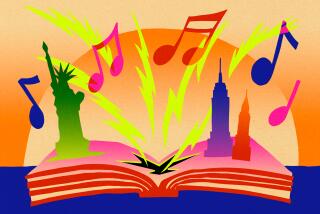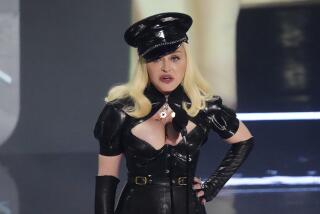He’s Defining Popular Music, From A to Z
- Share via
When British writer-publisher Colin Larkin came up with the idea of a 20-volume encyclopedia of pop music in the late ‘80s, his family and friends thought he was mad. And, he admits with a devilish chuckle, they may have been right.
It has taken Larkin seven years to complete the eight-volume edition of the set, which was just released, and he vows to expand the series by two volumes every three years until he reaches his original goal around the year 2016.
“I’m 48 now and if I can keep healthy, I think I can just about do it,” he says.
By the time he signs off on the 20-volume set, Larkin figures the series, titled “The Encyclopedia of Popular Music,” will have 60,000 entries. The first edition, published in 1992 and consisting of just four volumes, contained 10,000 subjects. The new eight-volume edition contains 18,500--about a quarter of which he wrote himself.
You’ll certainly disagree vigorously with many of the verdicts in the book’s five-star album rating system, but the reference aspect of the work is solid enough to establish the series as the pop equivalent of “The New Grove Dictionary of Music and Musicians,” the landmark classical music series that was Larkin’s model.
During a break from work on the next volumes in the series, Larkin spoke about what has become of his life obsession.
Question: How do you define the boundaries of pop?
Answer: The truth is the book ought to be called “The Encyclopedia of Nonoperatic and Nonclassical Music.” Because that’s what it is. That name would never sell, so we simply call it the encyclopedia of pop, but it is designed to include everything that “Grove” doesn’t--so that the two sets equal the whole of music. We go into rock, jazz, country, hip-hop and the rest.
Q: How did you come up with the original 10,000 names for the first volume? Did you take them from sales charts and other reference books?
A: No, sad to say, they pretty much all came out of the head. I’ve never thrown away a music magazine since 1961. And it was amazing, I sat down with a couple of colleagues and we started typing as many names as we could and within a couple of days we had something like 15,000 names, so it was then a matter of narrowing the list down. That original list now, by the way, is up to 45,000, and we’ve still only done 18,500. So we are all aware that we’ll never include everyone.
Q: Who has the honor of the longest entry?
A: Billie Holiday, with over 5,000 words, but it wasn’t intentional because I wouldn’t make her bigger than Bob Dylan or the Beatles. In the early days of doing the book, there were a few key people who were experts in certain fields, and that included Max Jones, who used to be the jazz editor of Melody Maker [magazine] and probably Britain’s leading expert on Billie Holiday. I asked if he would do 2,000 words on Billie Holiday, and he said, “I can’t possibly do this under 2,000, but whatever I write over 2,000 you don’t have to pay me.” And, he gave us 5,000 and I didn’t [have the heart] to cut it.
Q: So who do you think deserves the longest entry?
A: I’d say Dylan, Sinatra, Ellington, the Beatles, Elvis, the Rolling Stones . . . that group. They are all around 4,000 to 4,500.
Q: How about your personal favorite?
A: The book is dedicated to the Beatles, who changed my life. The last time it was dedicated to just John Lennon, but a journalist accused me of being pro-Lennon and anti-McCartney, and I didn’t want that to be an issue. Yes, I prefer Lennon, his songs, his voice, but I didn’t want any anti-McCartney creeping in, so I’ve repressed that.
Q: Looking back over all this history, what would you nominate as the golden age of pop?
A: It’ll surprise you, but I’d say the ‘60s and the ‘90s. I think the spirit of the ‘60s is in a lot of the music we’ve heard in the ‘90s, particularly with the American and U.K. indie bands. . . . People actually playing guitars again and sweating on stage. I’d include bands like Nirvana, Alice in Chains in America, and Oasis, the Verve, Ash, a lot of those in Britain. . . . And, of course, there is rap. I was very anti-rap at the beginning. I didn’t like the gangsta rap, the language. . . . But I really have swung into it. I think it’s a fantastic area of music.
*
The third edition of “The Encyclopedia of Popular Music,” edited by Colin Larkin, can be purchased at bookstores or from Grove’s Dictionaries at (800) 221-2123. $750.
*
Robert Hilburn, The Times’ pop music critic, can be reached by e-mail at robert.hilburn@latimes.com
More to Read
The biggest entertainment stories
Get our big stories about Hollywood, film, television, music, arts, culture and more right in your inbox as soon as they publish.
You may occasionally receive promotional content from the Los Angeles Times.










